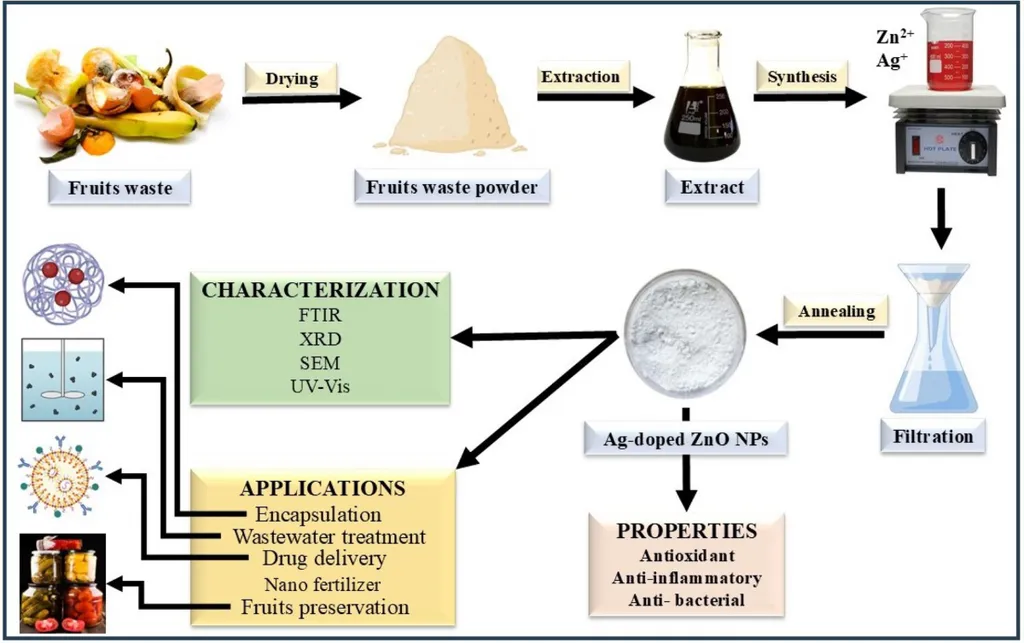In a groundbreaking study published in the journal Discover Materials (translated from Afrikaans as “Ontdek Materiale”), researchers from the Department of Chemistry at the Federal University Lokoja have unlocked new potentials for zinc oxide nanoparticles (ZnONPs) synthesized using fruit peel extracts. Led by Dr. Dailami S. A. Masokano, the research team explored the antifungal and photocatalytic properties of ZnONPs derived from banana, mango, and pineapple peels, offering promising avenues for the energy and environmental sectors.
The study employed green synthesis methods, utilizing aqueous extracts from banana (Musa spp), mango (Mangifera indica), and pineapple (Ananas comosus) peels to produce ZnONPs. These nanoparticles, labeled ZnO-BPE, ZnO-MPE, and ZnO-PPE respectively, were compared to a reference sample synthesized without fruit peel extract, termed ZnO-ppt. After calcination at 500°C, the samples underwent rigorous characterization using various techniques, including X-ray diffraction (XRD), Fourier transform infra-red spectroscopy (FT-IR), and UV-visible spectroscopy (UV-VIS).
The results revealed a hexagonal wurtzite crystalline structure typical of ZnONPs, with crystallite sizes ranging from 21 to 38 nanometers. Notably, the UV-vis spectra showed a narrow band gap in the range of 2.41–2.85 eV, indicating good UV light absorption across all samples. “The narrow band gap and excellent UV absorption properties of these nanoparticles make them highly suitable for photocatalytic applications,” remarked Dr. Masokano.
The study also delved into the antifungal properties of the synthesized ZnONPs. All samples demonstrated activity against Trichosporon sp and Aspergillus niger isolates. Notably, the ZnO-MPE sample exhibited the highest zones of inhibition against Trichosporon sp., while the ZnO-PPE sample showed the lowest minimum inhibitory concentration (MIC) of 62.5 µg/ml against Aspergillus niger. These findings highlight the potential of these nanoparticles in biomedical applications, particularly in combating fungal infections.
In the realm of environmental applications, the research team assessed the photocatalytic potential of the ZnONPs by evaluating their ability to degrade a 10 ppm methylene blue solution under UV-light irradiation. The results were impressive, with degradation rates ranging from 73% to 91%. The ZnO-MPE sample emerged as the best-performing photocatalyst, sustaining its efficiency over three regeneration cycles. “The high photocatalytic activity and stability of these nanoparticles make them promising candidates for water treatment and environmental remediation,” stated Dr. Masokano.
The commercial implications of this research are significant, particularly for the energy sector. The efficient photocatalytic degradation of organic pollutants, such as methylene blue, opens doors for the development of advanced water treatment technologies. These technologies can be integrated into industrial processes to reduce environmental impact and improve sustainability. Additionally, the antifungal properties of the ZnONPs could lead to innovative solutions in healthcare, agriculture, and food preservation.
As the world grapples with the challenges of pollution and antimicrobial resistance, the findings of this study offer a glimmer of hope. The green synthesis of ZnONPs using fruit peel extracts not only provides an eco-friendly alternative to conventional methods but also unlocks new possibilities for their application in various industries. The research conducted by Dr. Masokano and his team at the Federal University Lokoja is a testament to the power of innovative science in addressing global challenges.
Published in Discover Materials, this study paves the way for future research and development in the field of nanomaterials. The integration of green synthesis methods with advanced characterization techniques holds immense potential for creating sustainable and efficient solutions for the energy and environmental sectors. As we move towards a greener future, the insights gained from this research will undoubtedly shape the trajectory of nanotechnology and its applications.

